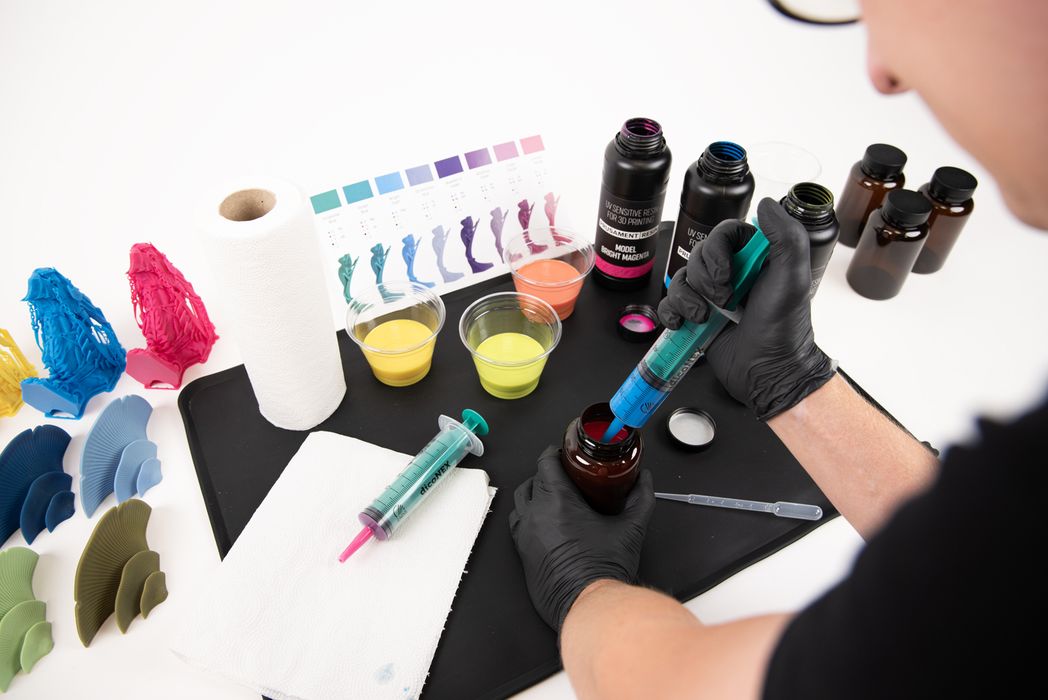
Prusa Research made two important announcements late last week, one involving resin coloring, and the other a critical certification.
Let’s look at the resin announcement first.
Resin Mixing Kit
The idea here is that resins are available only in certain colors, and there’s a problem if you want a different color. You could always just paint your resin print, but why not change the resin color?
That’s possible by mixing up your own resin color combo. Just as pixels on your screen make colors by combining R, G, and B light, it’s possible to make different colors by mixing base resin colors. Some resin 3D printer operators have done this for years, but it’s often a by-the-seat-of-your-pants approach. Carima offered a CMYK resin tinting kit two years ago, but now Prusa Research has their own version, the Prusament Resin Model Color Kit.
The kit contains bottles of Cyan, Magenta, Yellow, Black and White resins, which can be mixed to form unique colors. Note that these map to the famous CMYK color scheme used in 2D printing.
Prusa Research includes a calculator for determining the proper ratios for specific colors, with some 44 “recipes” provided.
The kit also includes the equipment needed to do the mixing, such as syringes to measure very small amounts, mixing cups, etc. Prusa Research is aware that when mixing new colors you often end up with leftover resin that must be stored separately from the base resins — you can’t just pour them back in the bottle. For that reason the kit includes several small storage bottles for mixed resins.
The kit, which includes 3kg of base resins, is listed at US$145.
New Prusa Certification
The company also announced they’ve received the UL 2904 GREENGUARD certification for their newest device, the MK4S desktop FFF 3D printer.
There’s a bit to explain here. It’s all about toxic emissions coming from the 3D printer. When the otherwise safe filament hits the hot end, the heat tends to cause the emissions of volatile organic compounds (VOCs) and nanoparticles. Both can be harmful if encountered in sufficient amounts.
This has been known for years, and we also know that ABS in particular is notorious for generating massively more emissions than other commonly used 3D printing materials.
UL 2904 is a specific measurement of these two categories in a controlled environment. The MK4S passed all tests, and thus gained the certification.
However, it’s a bit more complex than that: the emissions are a product of the printer AND the material used. In the testing for the certification, Prusa Research used PETG and PLA from their Prusament line.
Evidently the chemistry of the materials and the nature of airflow around the MK4S enabled the machine to pass the tests. However, if other materials are used — even PETG and PLA — from other providers the results might not be the same. Certainly they would not have passed if ABS was tested. Prusa Research recommends using an enclosure with appropriate HEPA filter for other materials.
If you’re thinking that this testing setup isn’t much different from other 3D printers, you’re not wrong. It’s very likely that most other desktop FFF 3D printers using reasonable materials would likely pass the same test. However, they have not done the test, and Prusa Research has done so.
Many equipment manufacturers might not bother getting the certification because it is an expensive thing to do, which is challenging if your corporate goal is to achieve the lowest possible machine price.
For Prusa Research this could be a big thing, as this certification could potentially open up new customers. Schools, for example, would be far more likely to purchase equipment that has official certifications — even if the machinery and materials aren’t any different than they were before. It’s the certification that matters.
As always, be safe when 3D printing.
Via Prusa (Resin) and Prusa (Certification)
